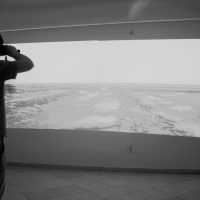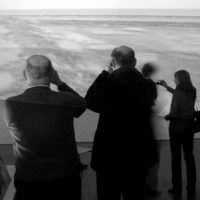The landscape projection and all the lighting in the installation is in the near infrared part of the spectrum that is completely invisible for the bare human eye but visible with night vision devices that are provided to the audience. This is based on the assumption that when much of the sun light is blocked out from reaching the surface of the earth as is in the nuclear winter scenario, seeing in infrared becomes more useful in terms of surviving.
The installation is presented in completely dark space producing sensations of emptiness and fullness simultaneously when the visitor is walking around the shelter and entering inside.
Besides the ironic use of widely used in the mass media concepts as nuclear winter and global warming, as a solution of each other the project raises the question of what is bringing the future and what output of the technology and contemporary society can be used for surviving in climate change environment.
One can trace references to pivotal sci-fi books and movies in the installation and also historical reminiscences with the old analog communication and electrical devices used.
The landscape video used in the installation is shot on the coastline of North Sea that in practice is the most heavily modified coastline during the human history but also the economic pool of the industrial revolution.
Thus the loop of the sped-up tide on the projection seems to close the circle of environmental and climate changes started with the industrial revolution. There is one more circle that is getting closed in the installation – the missing position of the guard of the coastline in the post-apocalyptic setup in the installation is replaced by the viewers who become observers of the environment but also observers of themselves.


